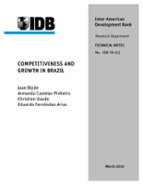Competitiveness and Growth in Brazil
Date
Mar 2010
In the first eight decades of the 20th century, Brazil ranked among the countries with highest growth rates in the world. During the period 1930-80, in particular, it managed to reduce its per capita income gap vis-à-vis industrialized economies and seemed poised to escape underdevelopment early in this century. However, this dream never materialized; Brazil's growth performance deteriorated sharply over the following quarter century, never fully recovering from the second oil shock and the foreign debt crisis. In this period Brazil experienced much lower and more volatile growth, with its long-term annual growth rate (ten-year moving average) fluctuating in the 2% to 3% range, well below the 6% to 10% range that prevailed in 1950-80. Brazil reacted by embarking on reforms, from trade liberalization to changes in fiscal and social policies. Policies improved, especially after price stabilization, in 1994, and, if anything, have been better than through most the high growth period, but apparently to no avail. Something happened in this later period that prevented Brazil from regaining the rapid growth that it had exhibited previously. What might it have been?



